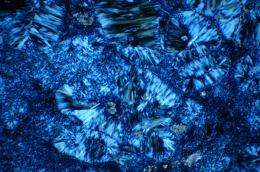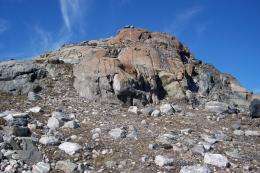First life may have arisen above serpentine rock, researchers say

(PhysOrg.com) -- About 3.8 billion years ago, Earth was teeming with unicellular life. A little more than 4.5 billion years ago, the Earth was a ball of vaporous rock. And somewhere in between, the first organisms spontaneously arose. Pinpointing exactly when and how that shift happened has proven a difficult bit of interdisciplinary detective work.
A team of Stanford geologists hasn't quite solved the problem, but they've come closer. By examining the geology and environment of the early Earth, the researchers demonstrate the plausibility of one theory: that life originated above serpentinite rock on the ocean bottom. Because the necessary conditions only existed for a few million years, the findings provide a potential timestamp for the appearance of the Earth's first organism.
The paper, authored by geophysics professor Norm Sleep, geological and environmental sciences professor Dennis Bird, and former graduate student Emily Pope, appears in this week's Philosophical Transactions of the Royal Society B.
Serpentinite under the sea
Greenish-colored serpentinite is common enough in California to be the official state rock. But geologists are more interested in deep-sea serpentinite deposits, where the mineral forms "white smoker chimneys" – hydrothermal vents – in which alkaline vent fluids interact with more acidic seawater.
The resulting reaction can form microscopic "pore spaces" in the chimney stone. This honeycombed rock acts as a percolator for white smoker fluid, concentrating dissolved substances inside the tiny spaces. Because the nucleic acids that make up RNA may have occurred naturally in vent fluids, this process increased the probability of spontaneously forming complete RNA strands. The tiny pores could have even allowed the resultant organisms to survive without cell membranes, using the rock itself for structure and protection.
The pH difference between the vent fluids and the ocean also could have provided an important energy supply for early organisms. When serpentinite is oxidized by seawater, hydrogen is formed. Microbes can react hydrogen with carbon dioxide to form methane or acetate, both of which serve as sources of chemical energy.

"These same conditions exist wherever water comes out of serpentine in the Bay Area," explained Sleep. "If you look, you can see hydrogen bubbling out of the ground."
But this model of life's origins is only feasible under very specific conditions. Serpentinite, a cool Earth, and an acidic ocean all must have coexisted for a time.
Serpentinite was likely present when life arose. Unfortunately, the geological record only reliably goes back approximately 3.8 billion years, making a definitive statement impossible. Still, under the West Greenland ice fields, Bird and Pope have recently identified serpentinite among some of the oldest rocks yet found.
The temperature of the Earth was also habitable at the time in question. A few hundred million years after its formation, the planet had cooled below 120°C – hot by human standards, but livable for certain microorganisms.
Acid enough?
The single most time-restricted requirement for early life would have been the acidity of the ocean. In order for early life to make use of a pH gradient between hydrothermal vents and seawater, the oceans must have been 100 times as acidic as they are today – a state of affairs that overlapped with a cool Earth for only a few million years.
The early oceans would have remained acidic as long as the early earth's atmosphere remained high in carbon dioxide. Much of the gas was eventually trapped in the earth's mantle by subducting continental plates.
"This leaves a relatively brief window for the origin of life, at least by this mechanism," said Sleep.
Smoking-gun evidence in support of the origin-of-life theory remains hard to come by. Geologists are currently looking deep in the Earth's crust for ancient white smoker structures. And the search continues for a modern-day version of membrane-less rock-living microbes.
"It's conceivable that a biologist might get lucky," Sleep said. "But I'm not holding my breath."
Provided by Stanford University


















